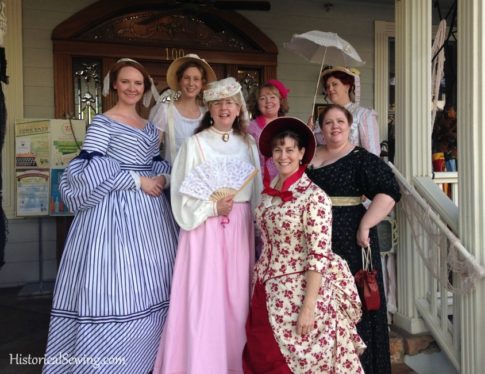
“How in the world did I get here?!?”
In the middle of a making a costume, do you ever stop and question how you got into this hot mess? “Why am I sewing this project today??”
Costuming isn’t just a “thing.” We are “involved.” As in a close relationship. As in, we show love and kindness and fear and hate and frustration and passion and dedication to the creative enterprise.
But WHY?
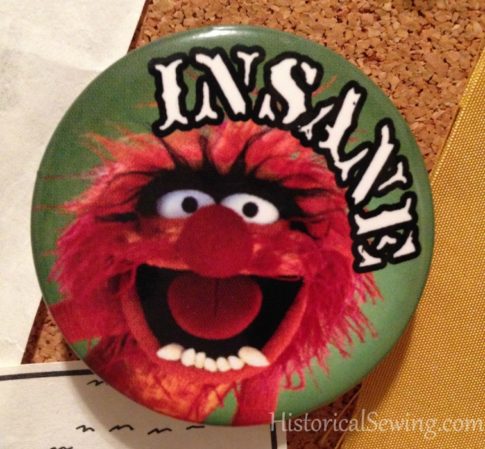
If you consider yourself “insane” when it comes to your historical sewing projects, I’ve got 5 ideas that I think help answer this for the sewing (and stress) we put ourselves through. To understand that what you’re doing matters.
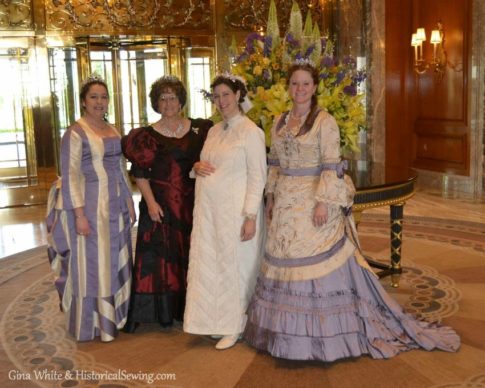
1. To Escape Reality and Play “Dress Up”
Who hasn’t wished for that impossible, but thoroughly delightful, adventure of jumping into a movie scene or book page to become part of the story?
Would you be the heroine or hero? How about the best friend? Or even the villain?
Honestly, why else do we toil for days and weeks to find a *pattern, *fabrics and trims, *practice familiar techniques and learn new ones and basically make ourselves crazy with completing a historical ensemble?
You sit down to view the latest Jane Austen adaptation and find yourself in love with a particular gown that you just have to have for yourself. Who cares if there is no other reason than to make something lovely to wear around the house? (Invite your friends over to view your latest vacation video over a scrumptious tea for a delightful afternoon!)
Few opportunities present themselves in our current society to vanish for a moment from our 21st Century lives and relive a part of history.
You could be a Crusader in the 12th Century or Rosie the Riveter in 1944 or anything in between.
Even if you don’t celebrate the holiday of Halloween, the excitement of becoming someone else and dreaming of another time period for a few hours is tempting and satisfying.
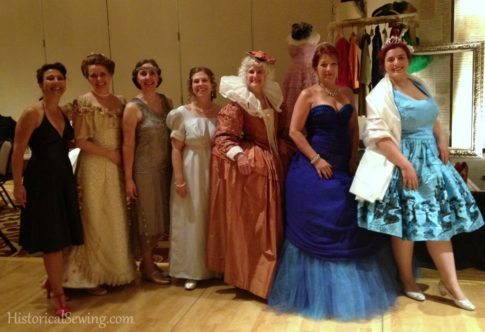
2. For a Social Event
This may be the strongest motivator in creating clothing from the past.
The Victorian Ball is coming up, and you don’t want to be the only one in modern clothes.
The Halloween party is an 18th Century masked ball.
New Year’s Eve is calling for your appearance in a 1920s jazz dress.
You’ve been invited to the local Civil War Blue/Gray Cotillion – period clothing required.
Making a historical ensemble to attend social events with friends is a most rewarding part of this hobby. Embrace those whimsical costume parties and build your historical sewing techniques while having fun.
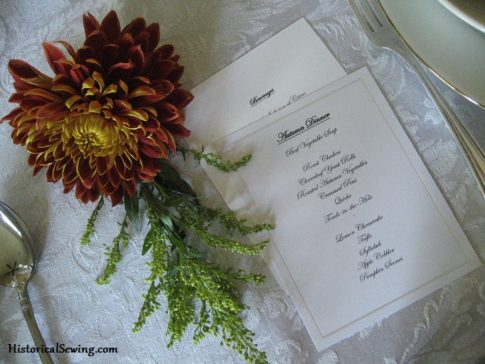
And if you can’t find a big event near you – create one! Get a couple friends together to picnic at the park or tour local gardens or museum (be sure to check their dress rules first!). Host a dinner with period recipes and appropriate attire.

3. For a Reenacting Event
For those with a love of historic information and a passion to share that knowledge with the current generation, you thrive at living history events. Getting a chance to pass on what our ancestors lived through is a means to learn from the past to eliminate future mistakes.
What better way than to combine your love of history with your love of period clothing! And you have a perfect excuse to wear your historical clothes more often. 😉
Whether an American Civil War weekend or visiting Colonial Williamsburg, each event will have its own guidelines for accuracy and historical dress. Be sure to check before getting knee deep into a new time period or project.
You may specialize in trying to get your period wardrobe as close as can be for the era you’re re-creating – fabulous!
But remember: you are a modern person and sew-er; you can only get so close to duplicating the picture. You can’t be totally 100% accurate. Although, I say challenge yourself to it if that’s your passion!
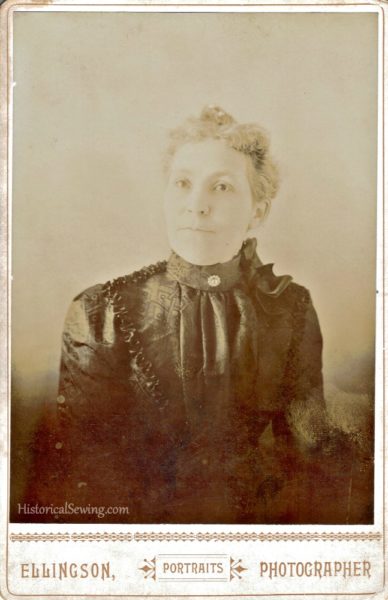
4. To Re-create a Family Heirloom or Historical Piece
Your grandparents’ 50th anniversary is next winter. You are planning the celebration – right down to the same cake and punch served.
Now you have to find a way to re-create your grandmother’s wedding gown. Perhaps you have only a photograph to rely on. Maybe you have the gown but the dear woman is not quite as skinny anymore.
You might take this as a challenge to expand your sewing skills. Delve into the research of why the gown has lace only on the cuffs and neckline. Or why there was no lace at all on it.
Why does a bodice found in an old trunk at the estate sale resemble 19th Century styles but has fabric that recalls the 18th Century? Why does that skirt have non-matching plaids for the lining?
If you can get your hands on a provenance (accurate historic ownership facts regarding an item) then use that in your research. Once collected, you’re good to go to use your new information and copy the piece.
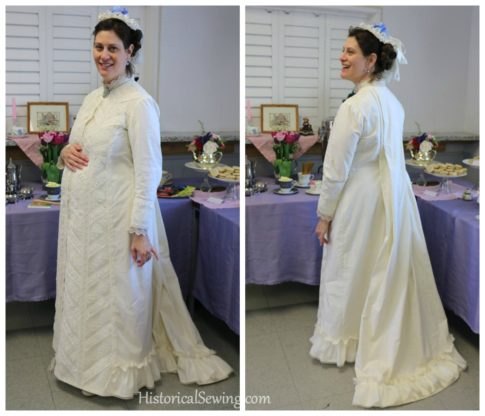
5. For Personal Achievement
If you are new to sewing historical fashion you may simply seek the challenge of completing a project to stretch your abilities. For the sheer enjoyment of the process. To expand your knowledge.
You may be looking for a new hobby to fill some free time. (I’m currently picking up knitting.)
Everyone has their own personal interests of where they like to spend their time whether that is sewing, music, sports, art, travel, or whatever. Perhaps historical sewing is an area that achieves personal fulfillment for you.
Maybe someone has inspired you to win an award at an event. Take that challenge! 🙂
Whatever reason pushes you to sew up clothing styles from the past take pride in your work! When that deadline is approaching and you’re stressed out to complete the costume on time come back to these special influences about why you are sewing a particular project.
Believe that making historical clothing sets you apart into a unique hobby.
Happy Sewing!

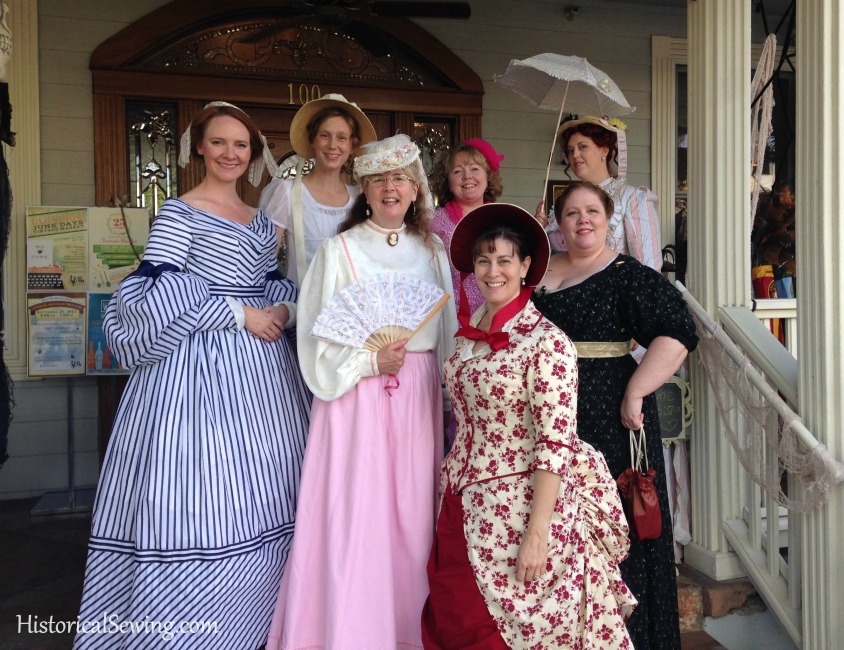
I started when my niece became involved in a period outdoor drama. The costumes were terribly wrong and I wanted them to be as close to historically accurate as possible and still be stage ready.
My husband and I meet through a reenactment group at the Southern California Renaissance Pleasure Faire – 29 years ago. We worked with the Clan McColin, a 16th Century Celtic group. We did historical research to present the most accurate replication of the lives and times of a people. We even made our own trims on my Inkle Loom. We raised our two daughters to participate with us.
Now, we hang out with pirates and Jedi and are becoming interested in the Steampunk phenomenon. I love the creativity and research that goes into each creation, be it fictional or factual. Yes, it is an excuse to play dress-up and play with time travel. I love it!
Thank you for the article! I think all of us have a variation of reasons which are often the same and sometimes different. For me, my interest in history also really plays a role. A part of what I like about historical costuming in particular (as opposed to fantasy for instance) is the research part of it. Finding out exactly how they did it ‘back in the day’ and why. The parallels between how people lived and how they dressed. 🙂
I am 16 years old, a grade 12 student, and will be wearing a historically accurate Victorian, early-bustle ballgown to my grad. Jennifer, her site, newsletter, and store, have and will continue to help me make my dream a reality. Thank you!
So glad you’ve found it all helpful Laura! Best of luck with your graduation dress!! 🙂
I have been sewing since I was a child. I just love being able to create something. Over 29 years ago, my husband and I started as docents at Sutter’s Fort in Sacramento. We couldn’t afford to buy everything already made so we started making our own. I make the bulk of our clothing, but he can too! I love hand sewing and showing the public that items can be made without a machine. I am currently making my husband a shirt from linen that I had hand stamped with a design. I can’t wait to see if finished – should be this weekend.
I like all five ideas but my favorite one is no. 1 . To Escape Reality and Play “Dress Up” I haven’t started sewing yet but I would love to escape reality and play dress up. I would love to dress up in a pretty dress or gown that women wore after the Civil War. I would like to pretend to be one of those ladies. That would be fun.
I belong to a dance group that performs at historical sites and events. I am forced to sew ( even though I’m not very good at it) as it’s the only way to get appropriate clothes.